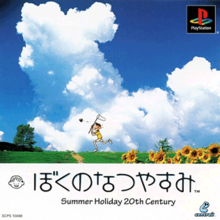| Boku no Natsuyasumi | |
|---|---|
 PlayStation cover art | |
| Developer(s) | Millennium Kitchen |
| Publisher(s) | Sony Computer Entertainment |
| Director(s) | Kaz Ayabe |
| Producer(s) | Contrail |
| Designer(s) | Kaz Ayabe |
| Artist(s) |
|
| Writer(s) | Kaz Ayabe |
| Composer(s) | Akiko Ukai |
| Platform(s) | |
| Release | PlayStation
|
| Genre(s) | Adventure, simulation |
| Mode(s) | Single-player |
Boku no Natsuyasumi (transl. "My Summer Vacation")[a] is an adventure video game developed by Millennium Kitchen and directed, written, and designed by Kaz Ayabe. It was published by Sony Computer Entertainment and released in Japan on the PlayStation on June 22, 2000. The game follows the summer vacation of Boku, a city-dwelling nine-year-old boy who in August 1975 is sent to stay with his extended family in the Japanese countryside for a month. Gameplay takes place in an open-ended environment where the player is free to determine how Boku spends the thirty-one in-game days of his summer vacation, with few set goals or specific obligations of gameplay progression.
Development of Boku no Natsuyasumi began in 1997, shortly after Ayabe left his position at the video game planning company K-Idea to establish Millennium Kitchen. Ayabe conceived of the game as a "nostalgic adventure" based in part on his own childhood summer vacations to the countryside homes of his relatives. The game features character design by illustrator Mineko Ueda and background work by the animation studio Kusanagi. The visual style is characterized by a juxtaposition of Ueda's cartoonish three-dimensional character models against these pre-rendered and hand-painted two-dimensional backgrounds.
Boku no Natsuyasumi was praised upon its release for its visual style, nostalgic atmosphere, and art direction, though critics noted that its open-ended ambitions were hampered by the technical limitations of the PlayStation platform. It has achieved a cult following both domestically and internationally, despite having never been officially released outside of Japan. The game won a New Wave Award at the fifth Japan Game Awards, and was a finalist for the Excellence Award at the third Japan Media Arts Festival. Three sequels have been produced: Boku no Natsuyasumi 2 (2002), Boku no Natsuyasumi 3 (2007), and Boku no Natsuyasumi 4 (2009). An enhanced port of Boku no Natsuyasumi, titled Boku no Natsuyasumi Portable: Mushimushi Hakase to Teppenyama no Himitsu!!,[b] was released on the PlayStation Portable in 2006.
Cite error: There are <ref group=lower-alpha> tags or {{efn}} templates on this page, but the references will not show without a {{reflist|group=lower-alpha}} template or {{notelist}} template (see the help page).